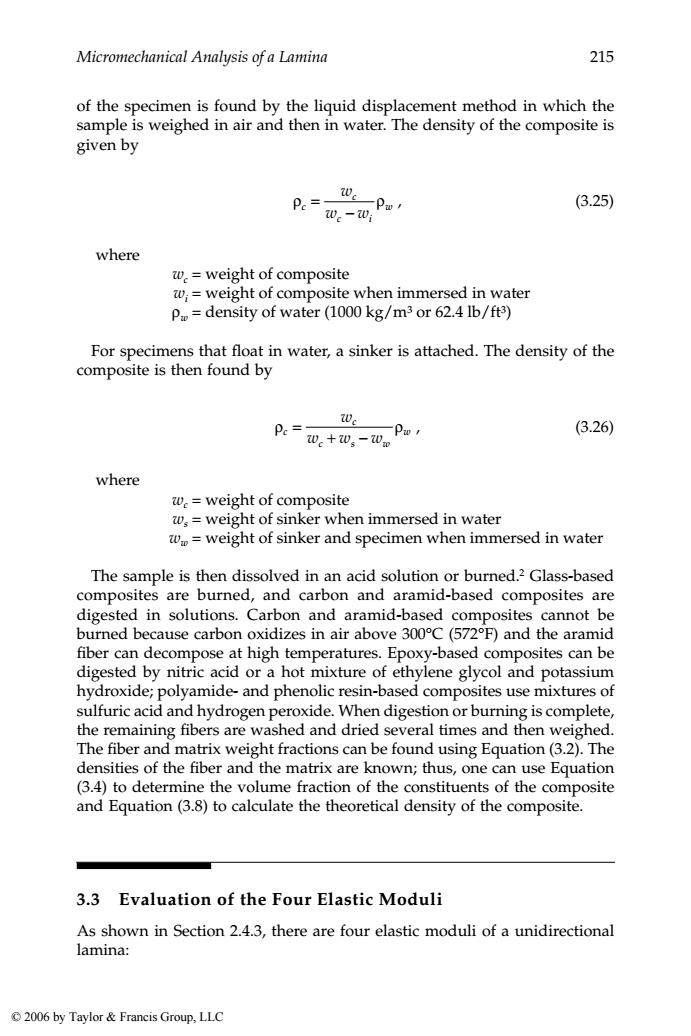正在加载图片...

Micromechanical Analysis of a Lamina 215 of the specimen is found by the liquid displacement method in which the sample is weighed in air and then in water.The density of the composite is given by P:= 0一Pw' (3.25) 0e-0: where w.=weight of composite w;=weight of composite when immersed in water P=density of water (1000 kg/m3 or 62.4 1b/ft3) For specimens that float in water,a sinker is attached.The density of the composite is then found by Pe=- Pw (3.26) 0e+0,-0m where w.=weight of composite w;=weight of sinker when immersed in water w=weight of sinker and specimen when immersed in water The sample is then dissolved in an acid solution or burned.2 Glass-based composites are burned,and carbon and aramid-based composites are digested in solutions.Carbon and aramid-based composites cannot be burned because carbon oxidizes in air above 300C(572F)and the aramid fiber can decompose at high temperatures.Epoxy-based composites can be digested by nitric acid or a hot mixture of ethylene glycol and potassium hydroxide;polyamide-and phenolic resin-based composites use mixtures of sulfuric acid and hydrogen peroxide.When digestion or burning is complete, the remaining fibers are washed and dried several times and then weighed. The fiber and matrix weight fractions can be found using Equation(3.2).The densities of the fiber and the matrix are known;thus,one can use Equation (3.4)to determine the volume fraction of the constituents of the composite and Equation(3.8)to calculate the theoretical density of the composite. 3.3 Evaluation of the Four Elastic Moduli As shown in Section 2.4.3,there are four elastic moduli of a unidirectional lamina: 2006 by Taylor Francis Group,LLCMicromechanical Analysis of a Lamina 215 of the specimen is found by the liquid displacement method in which the sample is weighed in air and then in water. The density of the composite is given by , (3.25) where wc = weight of composite wi = weight of composite when immersed in water ρw = density of water (1000 kg/m3 or 62.4 lb/ft3) For specimens that float in water, a sinker is attached. The density of the composite is then found by , (3.26) where wc = weight of composite ws = weight of sinker when immersed in water ww = weight of sinker and specimen when immersed in water The sample is then dissolved in an acid solution or burned.2 Glass-based composites are burned, and carbon and aramid-based composites are digested in solutions. Carbon and aramid-based composites cannot be burned because carbon oxidizes in air above 300°C (572°F) and the aramid fiber can decompose at high temperatures. Epoxy-based composites can be digested by nitric acid or a hot mixture of ethylene glycol and potassium hydroxide; polyamide- and phenolic resin-based composites use mixtures of sulfuric acid and hydrogen peroxide. When digestion or burning is complete, the remaining fibers are washed and dried several times and then weighed. The fiber and matrix weight fractions can be found using Equation (3.2). The densities of the fiber and the matrix are known; thus, one can use Equation (3.4) to determine the volume fraction of the constituents of the composite and Equation (3.8) to calculate the theoretical density of the composite. 3.3 Evaluation of the Four Elastic Moduli As shown in Section 2.4.3, there are four elastic moduli of a unidirectional lamina: ρ ρ c c c i w w w w = − ρ ρ c c csw w w www = + − 1343_book.fm Page 215 Tuesday, September 27, 2005 11:53 AM © 2006 by Taylor & Francis Group, LLC